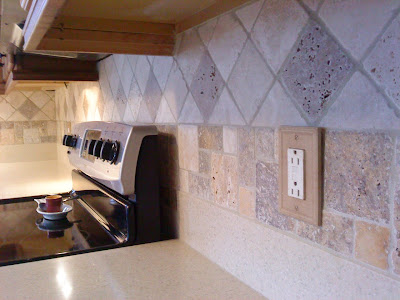Want to add some light to your yard and character as well? How about a lamp post?

Some clients of mine in Inglewood wanted me to install a lamp post that they had purchased to illuminate some stairs leading to a parking area at the side of their home. The light will help them not fall down the stairs, and look great in the daytime as well.
Installing a lamp post is actually fairly simple. The most complicated part is probably the wiring. It's much like wiring any other light fixture. If that's above your head, of course, call an electrician.
Here are the basic steps:
1. Find the perfect location for your new lamp post and dig a hole. Follow the recommended depth in the pole's instructions, but mine was around 18".
2. Put the post in the hole and fasten it to something so it will remain plumb while you do the concrete.
3. Figure out where you want the wire to go. In our case, we could go nearby into the home's basement. I dug a small ditch and buried a 14-2 waterproof wire. (It's the grey stuff). (If you're lost, call an electrician...) Think before you dig so you don't bust a water pipe or something.
4. Connect the wiring. In this case, the lamp actually has a sensor that will turn it on when it gets dark. I guess you wouldn't have to even have a switch for this. Even still, I installed a switch near the front door so the homeowners could turn it off if they wanted to.
5. With the electrical done, let's add some cement to that hole. Go get a bag or two of fast setting concrete that you can use to set posts without mixing. It's great. You just pour the bag into into the hole, then slowly pour around a gallon of water on top and let it seep into the mix. Within approximately 40 minutes, the concrete will set up and you can remove the supports.
That's about it. Expect to pay $100-150 for the post and fixture, and maybe another $25 if you don't have a post-hole-digger.. :)
-Peter
 I see a lot of homes with a crawlspace door that is either completely disfunctional due to water damage, or just insecure, perhaps held closed by a brick. Sure, it's just a crawlspace, but I'd prefer a door that is secure- so no one can steal all your copper pipes (I've heard horror stories about this) and various animals won't make a home under your house.
I see a lot of homes with a crawlspace door that is either completely disfunctional due to water damage, or just insecure, perhaps held closed by a brick. Sure, it's just a crawlspace, but I'd prefer a door that is secure- so no one can steal all your copper pipes (I've heard horror stories about this) and various animals won't make a home under your house. At the back of the home was a large plywood crawlspace door that was somewhat adequate, however, the homeowners had been using the space under the house for additional storage and they wanted something more secure.
At the back of the home was a large plywood crawlspace door that was somewhat adequate, however, the homeowners had been using the space under the house for additional storage and they wanted something more secure. To cover the frame I picked up a large 4 x 8 piece of James Hardie exterior sheet siding. It's similar to their popular lap siding, but it comes in these large pieces that are great for siding a shed or making a door. You can get them with a textured wood grain surface or with a smooth surface, which I used for this project.
To cover the frame I picked up a large 4 x 8 piece of James Hardie exterior sheet siding. It's similar to their popular lap siding, but it comes in these large pieces that are great for siding a shed or making a door. You can get them with a textured wood grain surface or with a smooth surface, which I used for this project.





 Once I got up on the roof to get a closer look it was obvious that the old rubber flange had deteriorated and had large cracks that was letting water get into the house with little trouble.
Once I got up on the roof to get a closer look it was obvious that the old rubber flange had deteriorated and had large cracks that was letting water get into the house with little trouble. 

















